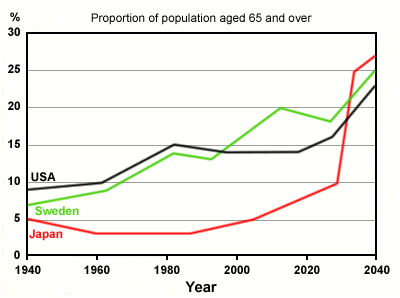Sample IELTS Task 1 Line Graph:
Proportion of Elderly
by Renas

The graph shows the proportion of the population aged 65 and over between 1940 and 2040 in three different countries.
The graph illustrate the comparison between three different countries USA, Sweed, and Japan in elderly. Overall, the proportion of three countries going up from 1940 to 2040.
In 1940 the percentage of ageing in USA was below 10%, while in Japan was 5%, however, Sweed came between them. In the following years the rate of elderly in both USA and Sweed increased dramatically and reached a pick by 15% and just below to nearly 13% respectively. But the rate in Japan decreased slightly over the same period.
Afterword, from the previous time which is from 2000 all mentioned countries expect ;to increase and make a new pick. The figure suggested in the following three decades significant increase in ageing in each three country. Japan will reach the highest percent and scoring a new rate which is more than 25%, and each of USA and Sweed will come behind in different rate.
==================================================
IELTS buddy
Feedback
Corrected Version:The graph
illustrates the comparison between compares the proportion of elderly people in three different countries, USA, Sw
eden, and Japan
in elderly. Overall, the proportion
of elderly citizens in the three countries
going up increases from 1940 to 2040.
In 1940
, the percentage of ageing
people in USA was below 10%, while in Japan
it was 5%.
However,
Sweden came between them.
In the following years the
rate proportion of elderly in both USA and Sw
eden increased dramatically and reached a
pick by peak of 15% and
just below to nearly 13% respectively. But the rate in Japan decreased slightly over the same period.
After
wards, from
the previous time which is from 2000, all
mentioned the countries expect to increase and make a new
pick peak.
The figure suggested In the following three decades
there will be a significant increase in ageing in each
of the three count
ries. Japan will reach the highest
percent level,
and scoring a new rate which is more than 25%, and
each of USA and Swe
den will
come behind in different rate. be below this, at 23% and 25% respectively.
==================================================
FURTHER COMMENTSOverall, you describe and compare things appropriately, but you have some problems with your language control.
It appears you are over-complicating things in places because as you can see I have often crossed things out because you have too much.
So try to keep things simpler.
I'd advise you to review some of the language of comparison needed to write line graphs and practice this.
Here you can view a lesson on describing a graph over time.Proportion / PercentageBe careful how you use these:
proportion of three countries = proportion of elderly citizens
percentage of ageing in USA = percentage of ageing people in USA
